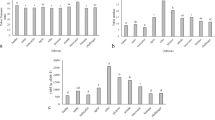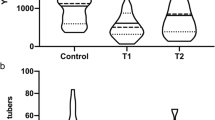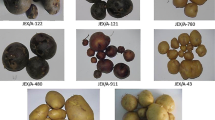Abstract
Screening of >800 somaclones of ‘Russet Burbank’, North America’s leading French fry cultivar, for improved yield and processing quality, led to the selection of 25 advanced lines. Three replicates of 3–5 tubers each from advanced lines were assessed after 5 months storage for antioxidant and polyphenol attributes; a subject receiving increased attention among plant breeders, nutritionists, and consumers. Phytonutrients affecting antioxidant components and total antioxidant capacity per serving (150 g fresh matter; one serving size) varied significantly among tubers of the 25 somaclones as well as between these somaclones and ‘Russet Burbank’ control plants (field tuber-derived and plantlet-derived). Several phenolics, including chlorogenic acid, caffeic acid derivatives, ferulic acid derivatives as well as the flavonoid rutin, ranged in concentration from 10- to 100-fold with some lines exceeding control tuber concentrations by >7-fold. Similarly, ascorbic acid ranged >3-fold (47.21 to 208.63 mg) on a per serving basis with some lines showing significantly greater concentrations than the control plantlet derived tubers (93.82 mg) by >2-fold. Antioxidant capacity, estimated using 2,2′-azino-bis (3-ethylbenzthiazoline-6-sulphonic acid) (ABTS), ranged up to 5-fold for the advanced somaclones (2,121.34 to 11,163.07 μM trolox equivalent/serving). Less variation occurred with other antioxidant capacity tests (DPPH, Folin-Ciocalteu). Overall 17/25 lines had increased antioxidant components. HPLC assays were necessary to confirm lines with better phytonutrient profiles. Somaclonal selection offers clear benefits for phytonutrient improvement in potato and can follow selection for yield and processing attributes.
Resumen
Las evaluaciones de más de 800 somaclones de “Russet Burbank”, variedad líder en Norteamérica para elaborar papas a la francesa, para mejorar el rendimiento y la calidad del procesamiento, condujo a la selección de 25 líneas avanzadas. Se analizaron tres repeticiones de 3–5 tubérculos de cada una de las líneas avanzadas después de cinco meses en almacenamiento, para atributos de antioxidantes y polifenoles; que son aspectos de la mayor atención entre fitomejoradores, nutriólogos y consumidores. Los fitonutrientes que afectan a los componentes antioxidantes y la capacidad total antioxidante por ración (150 g de materia fresca; tamaño de una ración) variaron significativamente entre tubérculos de los 25 somaclones, así como entre estos somaclones y las plantas testigo “Russet Burbank” (derivadas de tubérculos del campo y derivadas de plántulas). Varios fenoles, incluyendo el ácido clorogénico, ácido caféico, ácido ferúlico y el flavonoide rutina, variaron en concentración de 10 a 100 veces con algunas líneas, excediendo a las concentraciones de los tubérculos testigo por más de siete veces. Similarmente, el ácido ascórbico varió por más de tres veces (47.21 a 208.63 mg) con base a una ración, con algunas líneas mostrando significativamente mayores concentraciones que la plántula testigo derivada de tubérculos (93.82 mg) por el doble. La capacidad antioxidante, estimada usado 2,2′-azino-bis (3-ethylbenzthiazoline-6-ácido sulfónico) (ABTS), varió hasta por cinco veces más para los somaclones avanzados (2,121.34 a 11,163.07 μM trolox equivalentes/ración). Se presentó menor variación con otras pruebas de capacidad antioxidante (DPPH, Folin-Ciocalteu). En general, 17/25 líneas aumentaron sus componentes antioxidantes. Fueron necesarios ensayos con HPLC para confirmar las líneas con mejores perfiles de fitonutrientes. La selección somaclonal ofrece beneficios claros para el mejoramiento de fitonutrientes en papa y se puede seguir la selección para rendimiento y atributos de procesado.





Similar content being viewed by others
References
Al-Daej, M.I. 2009. Relative total phenolics in potato (Solanum tuberosum L.) progeny from 15 families. Ph.D. Thesis, Colorado State University, Colorado, USA.
Al-Saikhan, M.S., L.R. Howard, and J.C. Miller Jr. 1995. Antioxidant activity and total phenolics in different genotypes of potato (Solanum tuberosum L.). Journal of Food Science 60: 341–348.
Ah-Hen, K., C. Fuenzalida, S. Hess, A. Contreras, A. Vega-Gálvez, and R. Lemus-Mondaca. 2012. Antioxidant capacity and total phenolic compounds of twelve selected potato landrace clones grown in Southern Chile. Chilean Journal of Agricultural Research 72: 3–9.
Arnao, M.B. 2000. Some methodological problems in the determination of antioxidant activity using chromogen radicals: a practical case. Trends in Food Science & Technology 11: 419–421.
Augustin, J., R.E. McDole, G.M. McMaster, C.G. Painter, and W.C. Sparks. 1975. Ascorbic acid contents in Russet Burbank potatoes. Journal of Food Science 40: 415–416.
Bravo, L. 1998. Polyphenols: chemistry, dietary sources, metabolism and nutritional significance. Nutrition Reviews 56: 317–333.
Brown, C.R., I. Vales, S. Yilma, S. James, B. Charlton, D. Culp, D. Hane, C. Shock, E. Feibert, M. Pavek, R. Knowles, R. Novy, J. Whitworth, J. Stark, J.C. Miller Jr., D. Holm, R. Quick, and R. Navarre. 2012. “AmaRosa”, a red skinned, red fleshed fingerling with high phytonutrient value. American Journal of Potato Research 89: 249–254.
Cao, G., E. Sofic, and R.L. Prior. 1996. Antioxidant capacity of tea and common vegetables. Journal of Agricultural and Food Chemistry 44: 3426–3431.
Chinnici, F., A. Bendini, A. Gaiani, and C. Riponi. 2004. Radical scavenging activities of peels and pulps from cv. Golden Delicious apples as related to their phenolic composition. Journal of Agricultural and Food Chemistry 52: 4684–4689.
Chirinos, R., H. Rogez, D. Campos, R. Pedreschi, and Y. Larondelle. 2007. Optimization of extraction conditions of antioxidant phenolic compounds from mashua (Tropaeolum tuberosum Ruiz & Pavon) tubers. Separation and Purification Technology 55: 217–225.
Cho, K.S., H.-J. Jeong, J.-H. Cho, Y.-E. Park, S.-Y. Hong, H.-S. Won, and H.-J. Kim. 2013. Vitamin C content of potato clones from Korean breeding lines and compositional changes during growth and after storage. Horticulture, Environment and Biotechnology 54: 70–75.
Chun, O.K., and D.-O. Kim. 2004. Consideration on equivalent chemicals in total phenolic assay of chlorogenic acid-rich plums. Food Research International 37: 337–342.
Chun, O.K., D.-O. Kim, N. Smith, D. Schroeder, J.T. Han, and C.Y. Lee. 2005. Daily consumption of phenolics and total antioxidant capacity from fruit and vegetables in the American diet. Journal of the Science of Food and Agriculture 85: 1715–1724.
Dale, M.F.B., D.W. Griffiths, and D.T. Todd. 2003. Effects of genotype, environment, and postharvest storage on total ascorbate content of potato (Solanum tuberosum) tubers. Journal of Agriculture and Food Chemistry 51: 244–248.
Davies, C.S., M.J. Ottman, and S.J. Peloquin. 2002. Can germplasm resources be used to increase the ascorbic acid content of stored potatoes? American Journal of Potato Research 79: 295–299.
Ermer, J. 2005. Performance parameters, calculations and tests. In Method Validation in Pharmaceutical Analysis. A Guide to Best Practice, ed. J. Ermer and J.H. McB Miller. Weinheim: Willey-VCH Verlag GmbH & Co. KGaA. Chapter 2.
Escarpa, A., and M.C. González. 2001. Approach to the content of total extractable phenolic compounds from different food samples by comparison of chromatographic and spectrophotometric methods. Analytica Chimica Acta 427: 119–127.
Everette, J.D., Q.M. Bryant, A.M. Green, Y.A. Abbey, G.W. Wangila, and R.B. Walker. 2010. Thorough study of reactivity of various compound classes toward the Folin-Ciocalteu reagent. Journal of Agricultural and Food Chemistry 58: 8139–8144.
Ezekiel, R., N. Singh, S. Sharma, and A. Kaur. 2011. Beneficial phytochemicals in potato—a review. Food Research International 50: 487–496.
Hale, A.L. 2003. Screening potato genotypes for antioxidant activity, identification of the responsible compounds, and differentiating Russet Norkotah strains using AFLP and microsatellite marker analysis. Ph.D. Thesis, Texas A&M University, Texas, USA.
Hale, A.L., L. Reddivari, M.N. Nzaramba, J.B. Bamberg, and J.C. Miller Jr. 2008. Interspecific variability for antioxidant activity and phenolic content among Solanum species. American Journal of Potato Research 85: 332–341.
Halliwell, B., J.M.C. Gutteridge, and C.E. Cross. 1992. Free radicals, antioxidants, and human disease: Where are we now? Journal of Laboratory and Clinical Medicine 119: 598–620.
Hamouz, K., J. Lachman, P. Dvorak, M. Orsak, K. Hejtmankova, and M. Cizek. 2009. Effect of selected factors on the content of ascorbic acid in potatoes with different tuber flesh color. Plant, Soil and Environment 55: 281–287.
Han, J.-S., N. Kozukue, K.-S. Young, K.-R. Lee, and M. Friedman. 2004. Distribution of ascorbic acid in potato tubers and in home-processed and commercial potato feeds. Journal of Agricultural and Food Chemistry 52: 6516–6521.
Jansky, S. 2009. Breeding genetics and cultivar development. In Advances in potato chemistry and technology, ed. J. Singh and L. Kaur, 44–47. MA: Elsevier Inc.
Ji, X., L. Rivers, Z. Zielinski, M. Xu, E. MacDougall, J. Stephen, S. Zhang, Y. Wang, R.G. Chapman, P. Keddy, G.S. Robertson, C.W. Kirby, J. Embleton, K. Worrall, A. Murphy, D. De Koeyer, H. Tai, L. Yu, E. Charter, and J. Zhang. 2011. Quantitative analysis of phenolic components and glycoalkaloids from 20 potato clones and in vitro evaluation of antioxidant, cholesterol uptake, and neuroprotective activities. Food Chemistry 133: 1177–1187.
Kang, J.H., A. Ascherio, and F. Grodstein. 2005. Fruit and vegetable consumption and cognitive decline in aging women. Annals of Neurology 57: 713–720.
Kwon, O.Y., H.J. Kim, S.H. Oh, J.H. Lee, H.C. Kim, W.K. Yoon, H.K. Kim, C.S. Park, and M.R. Kim. 2006. Nutrient composition of domestic potato cultivars. Journal of the East Asian Society of Dietary Life 16: 740–746.
Külen, O., C. Stushnoff, and D.G. Holm. 2013. Effect of cold storage on total phenolics content, antioxidant activity and vitamin C level of selected potato clones. Journal of the Science of Food and Agriculture 93: 2437–2444.
Liu, S., J.E. Manson, I.M. Lee, S.R. Cole, C.H. Hennekens, W.C. Willett, and J.E. Buring. 2000. Fruit and vegetable intake and risk of cardiovascular disease: the women’s health study. American Journal of Clinical Nutrition 72: 922–928.
Liu, S., I.M. Lee, U. Ajani, S.R. Cole, J.E. Buring, and J.E. Manson. 2001. Intake of vegetables rich in carotenoids and risk of coronary heart disease in men: the physicians’ health study. International Journal of Epidemiology 30: 130–135.
Love, S.L., and J.J. Pavek. 2008. Positioning the potato as a primary food source of vitamin C. American Journal of Potato Research 85: 277–285.
Love, S.L., T. Salaiz, B. Shafii, W.J. Price, A.R. Mosley, and R.E. Thornton. 2003. Ascorbic acid concentration and stability in North American potato germplasm. Acta Horticulturae 619: 87–93.
Love, S.L., T. Salaiz, B. Shafii, W.J. Price, A.R. Mosley, and R.E. Thornton. 2004. Stability of expression and concentration of ascorbic acid in North American potato germplasm. HortScience 39: 156–160.
Malenberg, A.G., and O. Theander. 1985. Determination of chlorogenic acid in potato tubers. Journal of Agricultural and Food Chemistry 33: 549–551.
Martinez-Valverde, I., M.J. Periage, G. Provan, and A. Chesson. 2002. Phenolic compounds, lycopene and antioxidant activity in commercial varieties of tomato (Lycopersicum esculentum). Journal of the Science of Food and Agriculture 82: 323–330.
Mattila, P., and J. Hellstrom. 2007. Phenolic acids in potatoes, vegetables, and some of their products. Journal of Food Composition and Analysis 20: 152–160.
Musilova, J., J. Bystricka, J. Tomas, Z. Polakova, and S. Melichacova. 2009. Changes of vitamin C content in relation to the range of accumulation of Cd, Pb, and Zn in potato tubers. Czech Journal of Food Science 27: S192–S194.
Nassar, A.M.K., J. Abdulnour, Y. Leclerc, X.-Q. Li, and D.J. Donnelly. 2011. Intraclonal selection for improved processing of NB ‘Russet Burbank’ potato. American Journal of Potato Research 88: 387–397.
Navarre, D.A., S.S. Pillai, R. Shakya, and M.J. Holden. 2011. HPLC profiling of phenolics in diverse potato genotypes. Food Chemistry 127: 34–41.
Nováková, L., P. Solich, and D. Solichova. 2008. HPLC methods for simultaneous determination of ascorbic and dehydroascorbic acids. Trends in Analytical Chemistry 27: 942–958.
Novy, R.G., S.L. Love, D.L. Corsini, J.J. Pavek, J.L. Whitworth, A.R. Mosley, S.R. James, D.C. Hane, C.C. Shock, K.A. Rykbost, C.R. Brown, R.E. Thornton, N.R. Knowles, M.J. Pavek, N. Olsen, and D.A. Inglis. 2006. Defender: a high-yielding, processing potato cultivar with foliar and tuber resistance to late blight. American Journal of Potato Research 83: 9–19.
Ortiz-Medina, E., V. Sosle, V. Raghavan, and D.J. Donnelly. 2009. A method for intercultivar comparison of potato tuber nutrient content using specific tissue weight proportions. Journal of Food Science 74: S177–S181.
Re, R., N. Pellegrini, A. Proteggente, A. Pannala, M. Yang, and C. Rice-Evans. 1999. Antioxidant activity applying an improved ABTS radical cation decolorization assay. Free Radical Biology & Medicine 26: 1231–1237.
Reyes, L.F., J.C. Miller Jr., and L. Cisneros-Zevallos. 2005. Antioxidant capacity, anthocyanins and total phenolics in purple- and red-fleshed potato (Solanum tuberosum L.) genotypes. American Journal of Potato Research 82: 271–277.
SAS (statistical analysis systems). 2011. Version 9.2 of the SAS system for windows. Cary. NC, USA: SAS Institute Inc.
Shakya, R., and D.A. Navarre. 2006. Rapid screening of ascorbic acid, glycoalkaloids, and phenolics in potato using high-performance liquid chromatography. Journal of Agricultural and Food Chemistry 54: 5253–5260.
Stushnoff, C., D. Holm, M.D. Thompson, W. Jiang, H.J. Thompson, N.I. Joyce, and P. Wilson. 2008. Antioxidant properties of cultivars and selections from the Colorado potato breeding program. American Journal of Potato Research 85: 267–276.
Tarrago-Trani, M.T., K.M. Phillips, and M. Cotty. 2012. Matrix-specific method validation for quantitative analysis of vitamin C in diverse foods. Journal of Food Composition and Analysis 26: 12–25.
Vipin, D.P. Nair, A. Dairam, A. Agbonon, J.T. Arnason, B.C. Foster, and I. Kanfer. 2007. Investigation of the antioxidant activity of African potato (Hypoxis hemerocallidea). Journal of Agricultural and Food Chemistry 55: 1707–1711.
Wegener, C.B., G. Jansen, H.-U. Jurgens, and W. Schutze. 2008. Special quality traits of coloured potato breeding clones: anthocyanins, soluble phenols and antioxidant capacity. Journal of the Science of Food and Agriculture 89: 206–215.
Wegener, C.B., and G. Jansen. 2011. Cultivated and wild Solanum species as potential sources for health-promoting quality traits. Plant Genetic Resources: Characterization and Utilization 9: 324–326.
Wu, X., G.R. Beecher, J.M. Holden, D.B. Hayowitz, S.E. Gebhardt, and R.L. Prior. 2004. Lipophilic and hydrophilic capacities of common foods in the United States. Journal of Agricultural and Food Chemistry 52: 4026–4037.
Zhang, L., G.A. Porter, and R.J. Bushway. 1997. Ascorbic acid and glycoalkaloid content of Atlantic and Superior potato tubers as affected by supplemental irrigation and soil amendments. American Journal of Potato Research 74: 285–304.
Acknowledgments
The authors thank Ms. D. Farid (School of Dietetics and Human Nutrition, McGill University) for help with the total phenolics (FC, GAE) assay. We are particularly grateful for extensive field support from McCain Foods Canada Ltd. (Florenceville, NB, Canada) and use of processing and storage facilities at the NB Department of Agriculture & Rural Development (NBDARD) Wicklow Station (Wicklow, NB, Canada). We thank the NSERC Discovery Grant Program (D.J. Donnelly and S. Kubow) for their financial support. We also much appreciate the kindly and supportive editorial review process at American Journal of Potato Research.
Author information
Authors and Affiliations
Corresponding author
Rights and permissions
About this article
Cite this article
Nassar, A.M.K., Kubow, S., Leclerc, Y.N. et al. Somatic Mining for Phytonutrient Improvement of ‘Russet Burbank’ Potato. Am. J. Potato Res. 91, 89–100 (2014). https://doi.org/10.1007/s12230-013-9334-z
Published:
Issue Date:
DOI: https://doi.org/10.1007/s12230-013-9334-z




